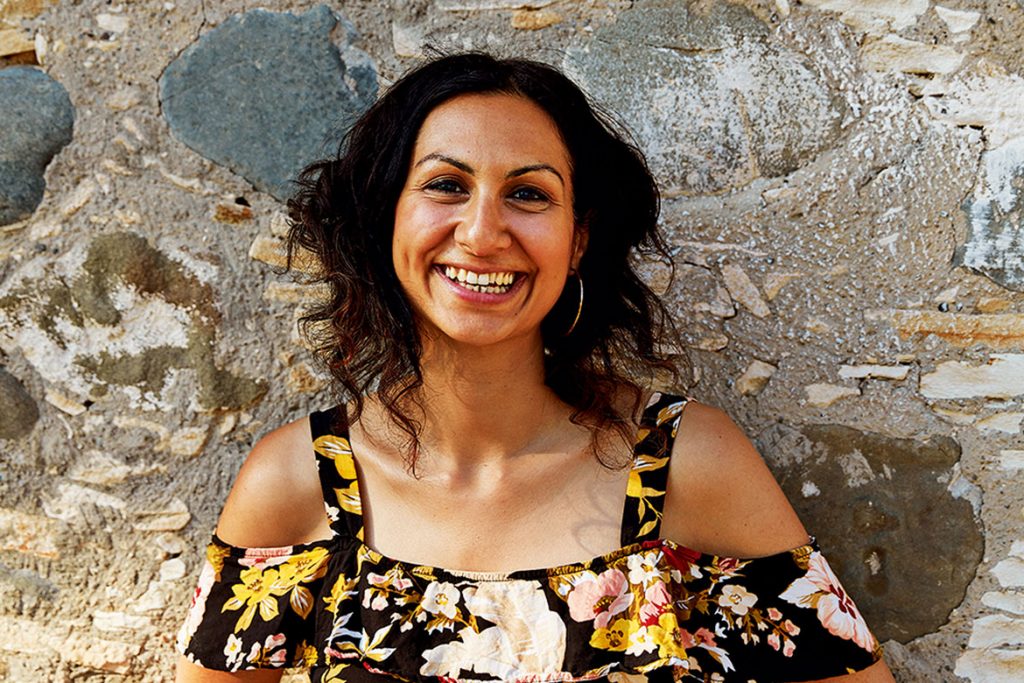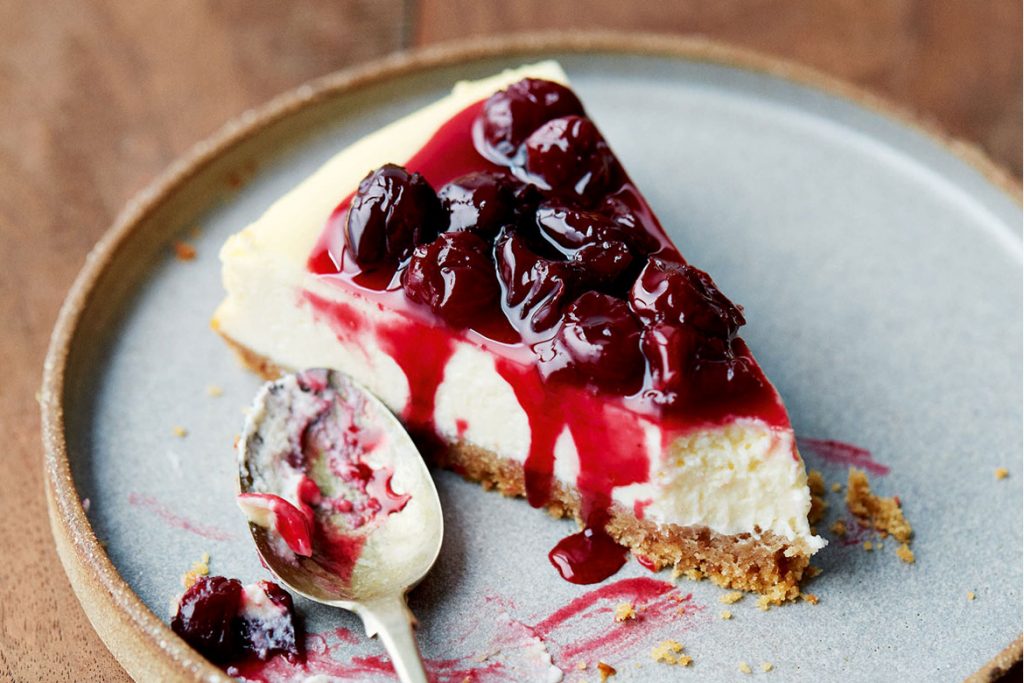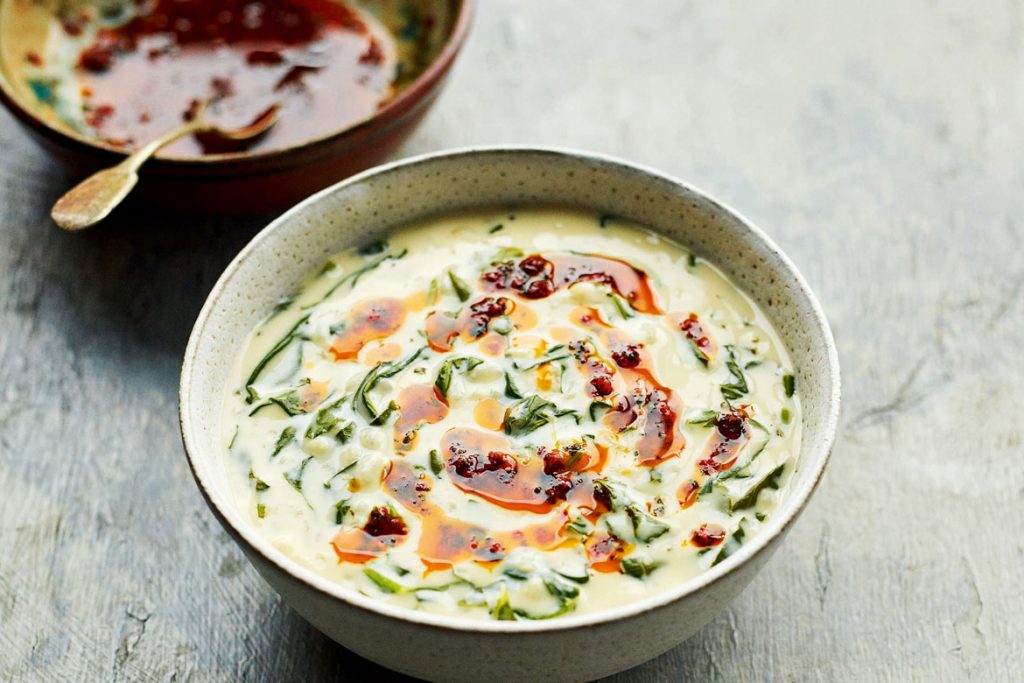In new cookbook Ripe Figs, campaigner and food writer Yasmin Khan illuminates the food and people – migrant, refugee and local – of the Eastern Med.
As you’d expect, there’s many a plum-coloured, tear-shaped fig in Yasmin Khan’s new cookbook, Ripe Figs. More so though, there is strength, pain, hope, heroism, loss, and lots and lots of olive oil.
“I get through too much olive oil,” says the London-based food writer with a laugh. “I definitely get through those big one-litre bottles probably more than I’d like to admit.”
It’s a crucial component in Eastern Mediterranean cuisines; even treated reverentially as a seasoning, not just a lowly cooking medium. “I love that,” says Khan, 40. “I just have a bottle of olive oil I bring to the table in the same way I’d have salt and pepper.” Those liberal sloshes of olive oil – be it in a Cypriot-style chocolate and orange mousse, or dressing barbecued sardines in vine leaves – embody the generosity and hospitality Khan chronicles in the book, through gleaned recipes and moving reportage.
It took four separate trips to the Eastern Med – each two to seven weeks long, over the course of a year – for Khan to pull together the stories she shares from cooks, restaurant owners, volunteers, migrants and refugees across Turkey, Cyprus and Greece. These encounters sit between ideas for hot yoghurt soup, sour cherry cheesecake and Afghan spiced pumpkin.
Take Lena – a teacher by day, restaurateur by night – of social enterprise NAN on Greek island Lesbos, which feeds locals and refugees alike (“The meals would take ages to arrive, but it didn’t really matter. You’d all be chatting and Lena would flit between the tables and always had a rolled up cigarette in her hands”) and Katerina, of Home for All, also on Lesbos, where equality is paramount, and people from the Moria refugee camp – prior to Covid and the camp burning down – were served meals on proper plates, on white tablecloths.
However, having worked as a campaigner on human rights issues for almost 20 years, covering everything from UK deaths in custody to the occupation of Palestine, Khan says researching Ripe Figs was arguably hardest – because “it’s so abstract, the refugee and migrant story”.
Between Trump’s presidency, Brexit and the coverage of Channel crossings, it’s one that’s dominated headlines in the last few years, “but when you actually are in these camps or speaking to people, and you hear the stories of how much people risk and what they go through, and what they get at the end of it; to say something is heart-breaking feels a little bit gauche or patronising,” says Khan. “It’s just so unjust.”
Ripe Figs, she hopes, will help change the persistently negative narratives around migration. “Don’t get me wrong, with the climate crisis, we are going to see huge numbers of people moving because they have to,” says Khan, but “it’s also really important to realise that throughout human history, for the thousands and thousands of years we’ve existed on this planet, we have always moved; people have moved through empires, for trade, for agricultural reasons. This notion of statehood and nation states is pretty modern.” Camps and human rights abuses seen at borders, are, “I think, trying to stifle something that has naturally existed for our species,” she adds.
Covid has of course added a layer of complication to an already complicated situation. “We’re in a pandemic, there’s a lot going on,” says Khan ruefully, acknowledging that the global context has shifted since she started writing the book. “There’s a lot of struggle in the world at the moment.” But food – sharing it, cooking it, eating it – can, she believes, cut through all that.
“Amidst this really difficult situation that many of the people I was speaking to found themselves in, we could always find ourselves smiling or laughing when we started sharing recipes, or when we were working in the kitchen,” Khan recalls. “Food and cooking; it’s one of the few ways you can escape the reality of what is going on around you. It can provide huge solace and comfort.”
It’s definitely been a distraction technique and way of travelling that many of us have eked cheer from during months of lockdown cooking. Khan, who is half-Pakistani, half-Iranian finds it “extraordinary” that through a recipe from a specific country, city or even town, you can “transport a little bit of that culture into people’s homes in other places in the world”. That you can pick up her cookbooks, which trace recipes from Iran (The Saffron Tales), Palestine (Zaitoun), and the Eastern Med (Ripe Figs), and recreate them “in Birmingham, or Brooklyn, or Berlin”.
And really, a plate of food is never just a plate of food. “When you learn about a food culture, you’re not just learning about a set of ingredients, you’re learning about a place’s history, its agriculture, its economy, maybe its gender relations, its climate,” says Khan. “Food has got such an extraordinary power to tell us a story.”
Be it Katerina or Lena, the people Khan spoke and cooked with weren’t just feeding hungry people dinner; meals were intrinsically braided with kindness; the cooks intent on preserving a person’s dignity, whatever their circumstances. “It was about telling someone, ‘I care about you, and I want you to know that I’m here, that there is support out there for you’,” explains Khan. “The food embodied that so much more than just the calories.”
Khan had three miscarriages during the course of writing the book. “I was interviewing a lot of people who are going through lots of grief; I was also going through similar processes,” she says, noting how grief – be it personal or collective – can affect our relationship with food and cooking. “Our appetite for life is so linked to our appetite for being able to enjoy food.”
She doesn’t obscure sadness or retreat from difficult moments, but there’s an irrefutable backbone of hope to Ripe Figs. Turning its pages, the red clay soils, grey-green olive trees and zing of the Eastern Med’s citrus fruits – all that “beautiful warming sunny food” – offer brightness, distraction, and a certain amount of freedom. “I know first-hand how much these recipes brought the people I was meeting with joy,” says Khan, “and how much they brought me comfort.”
Words by Ella Walker, PA
Pictures credit: Matt Russell/PA
Ripe Figs: Recipes And Stories From The Eastern Mediterranean by Yasmin Khan, photography by Matt Russell, is published by Bloomsbury, priced £26. Available now.
Sour cherry cheesecake, serves 8
INGREDIENTS
- 200g digestive biscuits
- 100g unsalted butter, melted
- 600g full-fat cream cheese, at room temperature
- 200g strained full-fat Greek-style yogurt
- 200g caster sugar
- 3 large eggs, lightly beaten
- 1tbsp plain flour
- 1tbsp vanilla extract
- 1tsp finely grated Unwaxed lemon zest
- 1tbsp lemon juice
- For the topping:
- 400g frozen, pitted sour cherries (see recipe introduction)
- 150g caster sugar
- 1tbsp cornflour
METHOD
- Line a 23cm springform cake tin with baking parchment. Put the biscuits in a food processor and blitz to crumbs. Alternatively, place them in a plastic bag and hit them with a rolling pin until they are finely crushed (the latter is slightly more therapeutic).
- Mix the crushed biscuits with the melted butter, then spoon into the prepared tin, pressing down the base to form an even layer. (I sometimes use the base of a cup or glass to even out the crumb.) Transfer to the refrigerator to set.
- Beat the cream cheese and yogurt until smooth. Whisk in the sugar, eggs and flour, then the vanilla, lemon zest and juice.
- Preheat the oven to 160°C/fan 140°C/Gas 3 (and see recipe introduction). Pour the filling into the chilled biscuit base and bake for around one hour. You can tell it is cooked when it looks set but still has a wobble in the middle. Now turn off the oven, open its door and leave the cheesecake to cool for 10 minutes without touching it. Remove it from the oven and leave to cool completely, then chill for four hours.
- To make the topping, place the frozen cherries and sugar in a saucepan over a medium heat. Stir frequently to begin with, so the sugar doesn’t catch. Once the cherries have defrosted and the sauce come to the boil, add the cornflour and simmer for five minutes. Set aside and leave to cool. To serve, either spoon the topping all over the cheesecake, or slice the cheesecake into pieces and place a dollop of cherries on top of each serving.
Hot yogurt & spinach soup, serves 4
INGREDIENTS
For the soup:
- 85g short or medium-grain white rice (I use Turkish baldo rice, but pudding rice would also work)
- 1L hot chicken stock
- 500g full-fat natural yogurt
- 1 large egg yolk
- 1½tbsp cornflour
- 200ml lukewarm water
- 1tsp dried mint
- 200g spinach, roughly chopped
- Salt and white pepper
For the topping:
- 40g salted butter
- 1½tbsp dried mint
- 1½tsp pul biber (Aleppo pepper), or other mild chilli flakes
METHOD
- Rinse the rice under running cold water for a few minutes so the starch washes out, then place it in a large saucepan. Pour in the hot stock, cover and simmer for 12–15 minutes, until the rice is cooked.
- In a bowl, whisk together the yogurt, egg yolk, cornflour and measured lukewarm water until smooth.
- When the rice is cooked, take a ladleful of its cooking broth and add it to the cold yogurt mixture, whisking as you do so to warm it up. Then take the saucepan with the rice in it off the heat and very slowly, half a ladle at a time, spoon in the yogurt mixture, whisking all the time so it doesn’t split.
- Return the soup to a medium-low heat and add the mint and half a teaspoon each of salt and white pepper. Simmer for five minutes until the soup has thickened. Add the spinach and cook for a further five minutes, then taste to adjust the seasoning to your preference. In a separate small saucepan, melt the butter for the topping with the dried mint and pul biber. When you are ready to serve, ladle the soup into warmed bowls, drizzle a couple of teaspoons of the hot chilli-mint butter over each portion and serve immediately.
Istanbul’s famous mackerel sandwiches, serves 2
INGREDIENTS
For the dressing:
- 2tbsp extra virgin
- Olive oil, plus more to serve
- 2tbsp lemon juice
- 1tbsp pomegranate molasses
- ¼tsp sumac
- ¼tspn pul biber (Aleppo pepper)
- ½ garlic clove, bashed
- Salt and black pepper
For the sandwich:
- ¼ small red onion, or enough for 2–3 rings per sandwich, or to taste
- 2 ciabatta rolls, each cut to the size of a mackerel fillet
- 2 mackerel fillets
- Olive oil
- Small handful of mint leaves, chopped
- 70g carrot (about ½ medium carrot), grated
- Large handful of rocket
- 1 ripe, juicy tomato, finely sliced
METHOD
- Put all the ingredients for the dressing in an empty jam jar with a quarter teaspoon each of salt and black pepper. Seal the jar, then shake vigorously and set aside for five minutes. Place the red onion in a shallow bowl, pour over the dressing (removing the garlic) and leave to marinate. (This removes some of the onion’s astringency.)
- Take a plate and cover it with kitchen paper, ready to soak up the oil from the mackerel later. Preheat the oven to 200°C/fan 180°C/Gas 6 and cut the pieces of ciabatta in half. Pop the bread in the oven for five minutes, so it warms up and is lightly toasted.
- Spoon a couple of teaspoons of the dressing over the flesh side of the mackerel, then season the fish generously with salt. Heat two tablespoons of regular olive oil in a frying pan over a medium-high heat. Add the mackerel, skin side down, and fry for three to four minutes. Once the skin has begun to crisp up, flip the fillets and cook for another one to two minutes on the other side, until just cooked through. While the fish is cooking, place the mint, carrot and rocket in the bowl with the onion and toss well. When the mackerel is ready, transfer the fish to the plate lined with kitchen paper and begin assembling the sandwiches.
- Drizzle the toasted bread with good-quality extra virgin olive oil. Then layer the mackerel on to the bread, followed by the tomatoes with a pinch of salt added, then the carrot mixture, then a couple of teaspoons of the dressing. Pop the top layer of bread on the sandwich and eat immediately!






Leave a Reply